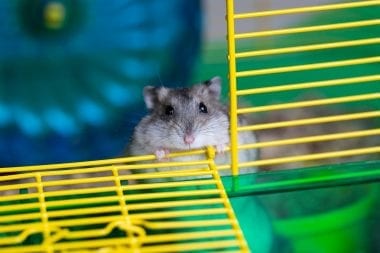Table of Contents Hide
If your hamster, shaking and quivering actions is typically a signal that something is wrong. Shaking in hamsters might indicate anything at all from the medical disease diabetes to the onset of a hibernation period. A shivering hamster should never be dismissed in any scenario.
It is difficult to witness your pet in obvious pain all the time. When their hamster starts trembling within the hamster cage, owners hunt for an immediate cure.
It is time to discover out what’s wrong when your hamster starts to tremble and shiver. If you are wondering why your hamster is trembling, this article explains why and how to resolve the problem.
Why should you consider checking on your trembling hamster?
The following are some of the advantages of taking action:
- Better Health
- Improved Life Quality
- Better Hamster Relationship
Consider this incident seriously since it might indicate that something must be severely wrong with your existing configuration.
Is it okay for hamsters to tremble?
If your hamster has ever been immobilized and trembling, you may be wondering if this is typical behavior. Even while it may appear unusual, it is typically very typical for them to do so.
Hamsters have a tendency to freeze and tremble a lot, especially when they are scared. What has terrified them typically doesn’t matter to hamsters- they will continue to behave in this manner.
Even if what shocked them was not a threat, they won’t be able to tell the difference at the moment because when anything shocks them, they won’t be able to distinguish. Because most things can frighten a hamster, they will do it irrespective of whether they are accustomed to you and their surroundings or not.
It is crucial to keep in mind that hamsters are predatory animals. So one of the main reasons they will stay put is if they believe something is threatening them.
For instance, if they are lying there immobilized from fear, they could believe the danger is nearby. When a hamster senses that an attacker is approaching, it will freeze in place to try to conceal.
Hamsters have a genetic inclination to remain motionless in their current location. It is almost as if they are frozen, to escape predators.
They may make it much more difficult for a possible predator to spot them this way. A hamster can do this for a variety of reasons.
Excessive noise, abrupt motions, or the presence of other pets might cause them to freeze and tremble in terror.
So, if you observe them immobilized and shivering, they may be afraid. They are scared of whatever they have seen or heard.
Why is my hamster trembling?
When a hamster is motionless, they may be doing so because they are on heightened alert.
So if you see them start to freeze up while playing in their cage. It is typically as they are attempting to sit still so that they might watch and listen to the surroundings.
Either way, they can evaluate the problem and determine whether there is a danger involved and they must flee. Else, whether nothing can be concerned about and they may go about their business.
Whenever a hamster is very terrified of anything, it will begin to shake. As its stress level rises, it may begin to tremble as a result of the dread.
Nevertheless, in certain circumstances, hamsters will tremble when they become chilly as well. So, if the room is a bit cooler than normal, they may be shaking not because they are afraid. It may be because they are chilly.
Something could have grabbed a hamster off guard and scared them if they are both frozen and shaking at the same moment. So, despite their fear, they are occasionally bold enough to sit motionless where they are. Then, they try to figure out what has surprised them and what is going on around them.
Should I be scared if my hamster is shaking and shivering a lot?
When you notice your hamster sitting motionless and shaking a lot, it is natural to be concerned.
However, most of the time, it is nothing to be concerned about. Because it might be difficult for them to communicate vocally at times, it’s only one of the various ways a hamster might indicate how they’re feeling at the time. It is something you may witness frequently because hamsters exhibit these behaviors frequently during their lives.
It is something you will notice right after you adopt them and bring them home for the first time. Also, it is something you will notice even after they have become attached to you.
It will be as long as your rodent behaves normally and appears to be in good condition. If you find that your pet does it all the often and you start to see indicators of health problems, call your doctor.
That way, the veterinarian may examine your hamster thoroughly and perhaps diagnose the problem.
However, if your hamster appears to be normal but continues to freeze and shake. There are a few things you may do to encourage them to stop.

What are the different reasons for shaking?
- Shaking due to Hibernation:
Hamsters do shake, and it is sometimes associated with extreme cold. Hamsters go into a low-energy condition comparable to hibernation when conditions are abnormally chilly. Similar to hibernation patterns in other animals, this state of restricted activity is intended to save energy.
Although a “hibernating” hamster appears to be lifeless, it is still breathing. If your hamster goes into hibernation, move him to a safer location right away. Stroke his body gently to help him to warm up. You can see the small rodent’s vigor and alertness return as he heats up gradually.
You could see his body trembling a bit as he stops lying down. For your hamster, the entire process of waking up from hibernation and raising body temperature might take up to an hour. As he returns to his usual state, keep a close eye on him and contact your veterinarian if you see any problems.
- Problems in Nervous System:
Shaking isn’t necessarily linked to hibernation in hamsters. Shaking can also be caused by problems with a hamster’s neurological system. Excessive stimulation of the system, such as touching a hamster, can occasionally cause odd muscular actions, such as uncontrollable body shaking or sudden body rolling over.
If a hamster’s shaking is caused by a nervous system disorder, the best remedy is to constantly treat it with care.
- Medical Abnormalities:
Shaking is a sign of a variety of medical disorders in hamsters, including diabetes. Shaking can be a sign of exhaustion, cardiogenic shock, skin parasites, heat exhaustion, and hyperglycemia. Take your little pet to the doctor as quickly as possible to make sure his shaking is not an indication of a potentially dangerous health problem — no excuses.
According to the American Society for the Prevention of Cruelty to Animals, shaking is a common sign of a health concern in hamsters. Watery stools, nasal discharge, weight loss, glazed over eyes, and a rough, tangled coat appearance are all frequent symptoms of health concerns to watch for.
- Anxiety:
Humans and hamsters both tremble when they are scared or nervous. Shaking may occur when you touch a hamster that is new to your home, for example. You may have a particularly bashful little rodent on your hands.
However, with just a little patience and time, your hamster will likely become accustomed to you and stop shaking. To be extra cautious, take your fluffy baby to the veterinary to make sure his condition is in good working order.
- Colder Cage:
There is another cause for a hamster is cage shaking. The reason for this is because the hamster is chilly and the temperature has plummeted to the point where they are visibly shivering.
The degree of shaking and the amount of hair covering their skin varies from hamster to hamster.
It is crucial to understand that each hamster will respond differently to falling temperatures. It is critical to figure out why they are reacting the way they are and come up with a solution right away.
The following are some reasons why hamsters do this:
- Energy conservation
- Temperature-Induced Biological Response
- A Simple Indicator of Difficulty
Many hamster owners are unaware that a hamster cage may become chilly.
It is why you must take the time to learn about the requirements for keeping the hamster cage warm throughout the winter months. Alternatively, your hamster will tremble due to the cold, and you will be stumped.
How to stop my hamster from trembling and keep it warm?
- Heating Pads:
A heating pad is one of the greatest remedies a hamster keeper can use. Heating pads for hamster cages are perfect since they are consistent, long-lasting, and easy to assemble.
You will know the heating pad will give a certain level of heat and will be tailored to satisfy the demands of a hamster. You may find it difficult to maintain a comfortable temperature without a reliable heating pad.
The following are some advantages:
- A Heat Source That Is Specifically Targeted
- Hamster Protection That Is Consistent
- The setup is simple.
There is not a valid reason to use alternative solutions since they will not last longer or keep your hamster secure. This low-cost investment is ideal for a hamster that shakes or shivers.
If your hamster is in pain, you must move quickly to find a lasting remedy. In most circumstances, the only method to achieve this is to purchase a high-quality hamster cage heating pad. It will allow you to rest easy knowing that your hamster is safe, regardless of how chilly it is outdoors.
- Keeping Room Warmer:
If the indoor temperature around the hamster cage is excessively chilly, the hamster’s health will suffer significantly.
In speaking, the hamster should be kept in a cage that is kept at normal body temperature. It is cozier, more laid-back, and will keep the hamster safe no matter what happens outdoors.
Allowing the room temperature to decrease will hurt the hamster, and they will notice it immediately.
Take frequent temperature readings to observe when the hamster is the coldest throughout the day while evaluating a room’s temperature. You’ll be able to adjust the heat in your room and make it more inviting.
It is suggested that you concentrate on learning how to keep a hamster warm.
- Hamster Beddings:
Investing in heated hamster bedding is a long-term adjustment that may be made.
Out in the wild, hamsters don’t have the luxury of locating warm heaters. As a result, they begin to search for warm bedding material to use during burrowing. As a result, you will want to recreate the identical concept using high-quality hamster bedding materials.
Allowing them to relax in a warm location will ultimately alleviate their trembling.








